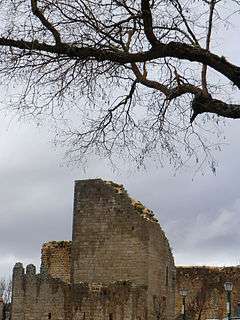Castle of Miranda do Douro
The Castle of Miranda do Douro (Portuguese: Castelo de Miranda do Douro) is located in the civil parish of Miranda do Douro, municipality of Miranda do Douro, in the Portuguese district of Bragança.
The boundaries of castle is connected to Algoso castles of Roias Feathers and Mogadouro, as well as the more distant of Braganza. Those three compose the so-called core of the trans Northeast.[1]
| Castle of Miranda Do Douro | |
|---|---|
| Castelo de Miranda do Douro | |
 | |
| General information | |
| Location | Miranda do Douro Village |
History
Ancient Times
The town originated during the Celtic times and survived during the Roman invasion of the Iberian Peninsula. It survived through the Roman presence and later saw the influence under the Suebi, Visigoths and the Muslims in their conquest of the region, toward the end of the eighth century and early ninth century.
Medieval castle
Early History
At the time of the Christian Reconquest of the region, troops of King of Afonso I in 857 came to the region.
Medieval Era
In the year 1093, the western limits of Galicia included mirandino section of the Douro river and came under the domain of Portucalense county that was successively ruled by the Count Henry, by his widow, the Countess Teresa, and their son, Afonso Henriques.
During this period the town was already defended by a castle, left in ruins by the struggles of Reconquista.
During the campaigns to take Galicia, the suspension of campaigns in 1135 encouraged Afonso Enriques to employ this period of peace to restore castles, monasteries and churches in strategic places like Miranda do Douro. Aiming to build up the settlement and defense, the village received tenure in 1136, coming to be in place Couto and safe havens. Thus, the town grew around the castle, been growing about or at the end of the reign of this king, or his successor, D. Sancho I (1185-1211). The struggles waged by D. Sancho I and his son and successor, Alfonso II (1211-1223), with Alfonso IX of León, that in the last year of the twelfth century, and this in the end of the first quarter of the thirteenth century, the lands Miranda were plagued by Leoneans who just returned the castle in 1213. The charter of the town was confirmed in Coimbra, in 1217.[2][3]
Under the reign of King Dinis (1279-1325), the village had its charter confirmed, with the privilege of never leaving the Crown (Santarém, December 18, 1286). The town's defenses and its castle were rebuilt in 1294.
One of the major improvements campaigns came under D. João I (1385-1433), which since its acclaim as a conductor had at his side the representatives of Távoras, prominent family in Miranda do Douro and whose castle he did alcaide- Major, when already the King in 1385, Pedro Lourenço de Távora. To align the party of John I and shortage of residents, the village was occupied on several occasions during the course of the military campaign that followed, held by Castilian forces. Thus, aiming at increasing its settlement, there instituted the monarch Couto privilege for sixty homiziados. In 1402, granting him, in subsequent years, other privileges.
Under the reign of King Manuel I (1495-1521), its defenses are analyzed and recorded by Duarte de Armas (Book of Fortresses, circa 1509). In that time, the town its new Forla set in Santarém on 1 June 1510.
Late middle ages
Peace with the Spaniards brought great prosperity to the town, which became one of the most important centers of trade between the two countries. Miranda do Douro became its own diocese and was elevated to city status through a Royal Letter dated 10 July 1545). During this first episcopal period from the mid-sixteenth century to the mid-eighteenth century enjoyed its greatest splendor, as capital of Tras-os-Montes Province, the only diocese in the province and an important military center. Subsequent military events have to cause its decline, which was accentuated by the permanent loss of his episcopal distinction.
Characteristics
The castle had plant in square format, with its walls, granite and schist, connected and reinforced in the three exterior angles by turrets (two rectangular plant and one hexagonal), involving a large parade ground, now reduced to a large yard.
To the north, the assembly is dominated by the castle keep, standing 682 meters above sea level.
About the village encompassed a total perimeter of six hundred steps, torn by three broken bow doors:
- Port of Lady of Perpetual Help, to the Costanilha street background;
- False door, next to the castle district; and
- the Postigo, east, on the bank of the Douro river.
References
- ↑ "Monumentos". www.monumentos.pt. Retrieved 2016-02-19.
- ↑ "IPA Cultural Association". Government of Portugal. Retrieved February 19, 2016.
- ↑ "Castle of Miranda Do Douro". Patrimonio Cultural. Retrieved Feb 19, 2016.